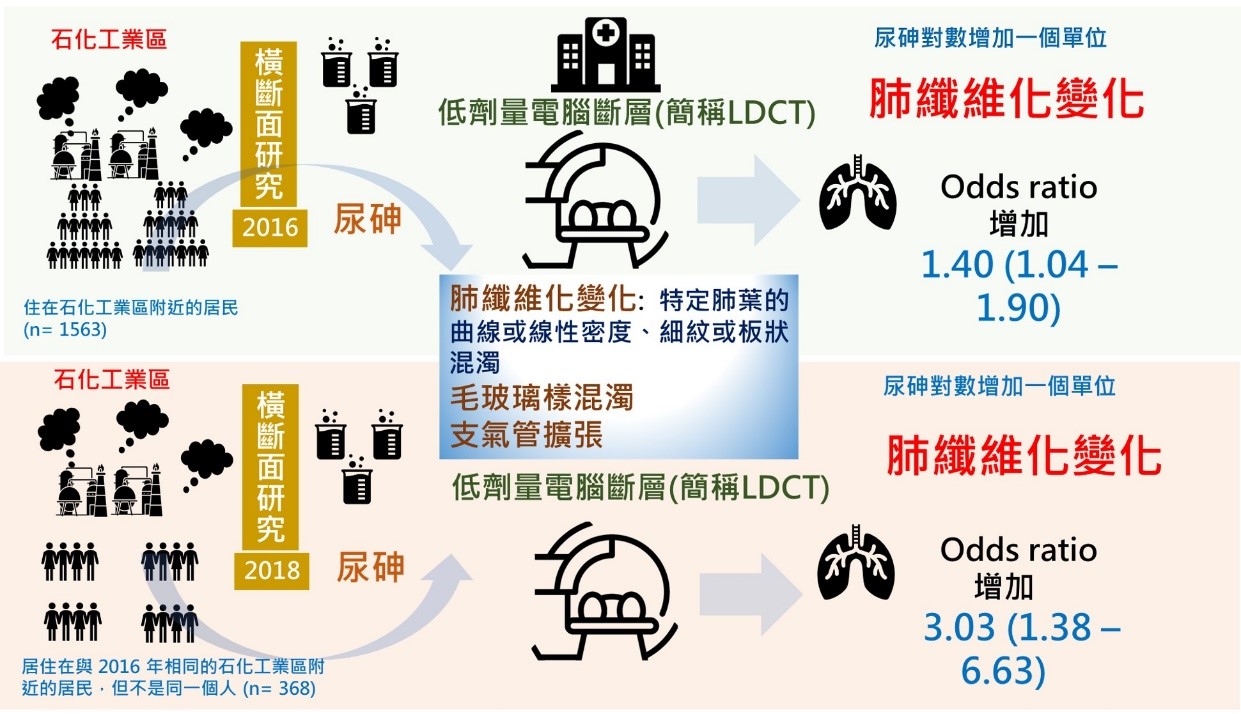石化廠附近非吸煙個體的砷暴露與肺間質變化相關:一項重複橫斷面研究
石化廠附近非吸煙個體的砷暴露與肺間質變化相關:一項重複橫斷面研究
砷暴露與氣道發炎和肺功能檢查下降有關。 砷暴露是否與肺間質變化有關尚不清楚。 我們在2016年至2018年期間在台灣南部進行了這項基於人群的研究。 我們的研究招募了20歲以上、居住在石化廠附近且無吸菸史的個體。 在2016年和2018年的兩次橫斷面研究中,我們進行了胸部低劑量電腦斷層掃描(LDCT),以及尿液砷和血液生化分析。 肺間質變化包括肺纖維變化,定義為特定葉葉中存在曲線狀或線狀密度、細線或板狀密度;此外,其他間質變化定義為LDCT影像上存在的玻璃狀密度(GGO)或 支氣管擴張。 在2016年和2018年進行的兩次橫斷面研究中,肺纖維變化的參與者與那些沒有纖維變化的參與者相比,尿砷濃度的平均值顯著增加(幾何平均值= 100.1與82.8μg/ g肌酸酐,p <0.001用於2016年橫斷面研究,幾何平均值= 105.6與71.0μg/g肌酸酐,p <0.001用於2018年橫斷面研究)。 在控制了年齡、性別、體重指數、血小板計數、高血壓、天門冬胺酸氨基轉移酶、膽固醇、HbA1c和教育程度後,我們觀察到對數尿砷濃度的單位增加與肺纖維變化風險之間 有顯著正相關,2016年橫斷面研究(Odds ratio[OR] = 1.40,95%信賴區間[CI] = 1.04–1.90,p = 0.028)和2018年橫斷面研究(OR = 3.03,95%CI = 1.38–6.63,p = 0.006)。 我們的研究並未發現砷暴露與支氣管擴張或GGO之間有顯著關聯。 我們建議政府有必要採取重大措施,以降低居住在石化廠附近的個人的砷暴露量。
圖形摘要

【研究團隊】
團隊成員:洪志興教授、陳思嘉教授、王志文助理教授、吳大緯助理教授
代表單位:高雄醫學大學精準環境醫學研究中心
研究聯繫Email:chinwin.wang@gmail.com
【論文資訊】
論文出處:Environmental Pollution, 2023 Aug 15;331(Pt 2):121844
全文下載:https://doi.org/10.1016/j.envpol.2023.121844
Arsenic exposure associated with lung interstitial changes in non-smoking individuals living near a petrochemical complex: A repeated cross-sectional study
Arsenic exposure associated with lung interstitial changes in non-smoking individuals living near a petrochemical complex: A repeated cross-sectional study
Arsenic exposure is associated with airway inflammation and decreased lung function tests. Whether arsenic exposure associated with lung interstitial changes remains unknown. We conducted this population-based study in southern Taiwan during 2016 and 2018. Our study recruited individuals aged over 20 years, residing in the vicinity of a petrochemical complex and with no history of cigarette smoking. In both the 2016 and 2018 cross-sectional studies, we conducted chest low-dose computed tomography (LDCT) scans, as well as urinary arsenic and blood biochemistry analyses. Lung interstitial changes included lung fibrotic changes that were defined as the presence of curvilinear or linear densities, fine lines, or plate opacity in specific lobes; additionally, other interstitial changes were defined as the presence of ground-glass opacity (GGO) or bronchiectasis on the LDCT images. In both cross-sectional studies conducted in 2016 and 2018, participants with lung fibrotic changes exhibited a statistically significant increase in the mean urinary arsenic concentrations compared to those without fibrotic changes (geometric mean = 100.1 vs. 82.8 μg/g creatinine, p < 0.001 for cross-sectional study 2016, and geometric mean = 105.6 vs. 71.0 μg/g creatinine, p < 0.001 for cross-sectional study 2018). After controlling for age, gender, body mass index, platelet counts, hypertension, aspartate aminotransferase, cholesterol, HbA1c, and educational levels, we observed a significant positive association between a unit increase in log urinary arsenic concentrations and the risk of lung fibrotic changes in both cross-sectional study 2016 (odds ratio [OR] = 1.40, 95% confidence interval [CI] = 1.04–1.90, p = 0.028) and cross-sectional study 2018 (OR = 3.03, 95% CI = 1.38–6.63, p = 0.006). Our study did not find a significant association between arsenic exposure and bronchiectasis or GGO. It is imperative for the government to take significant measures to reduce arsenic exposure levels among individuals living near petrochemical complexes.
Graphical Abstract:

Highlight:
1.A repeated cross-sectional study was conducted near a petrochemical complex.
2.Low-dose computed tomography was used to evaluate lung interstitial changes.
3.Individuals with lung fibrotic changes had higher urinary arsenic levels.
4.Elevated arsenic levels significantly increased lung fibrotic changes risk.
5.Repeated cross-sectional study confirmed arsenic-lung fibrotic changes association.
Research Team Members:Chih-Hsing Hung,Szu-ChiaChen,Chih-WenWang,Da-WeiWu
Representative Department:
Research Centre for Precision Environmental Medicine, Kaohsiung Medical University (KMU), Kaohsiung City, Taiwan
Contact Email: chinwin.wang@gmail.com
Publication: Environmental Pollution, 2023 Aug 15;331(Pt 2):121844
Full-Text Article: https://doi.org/10.1016/j.envpol.2023.121844


